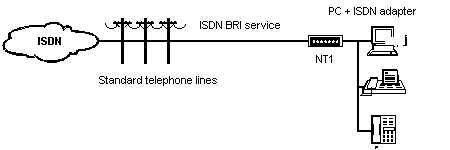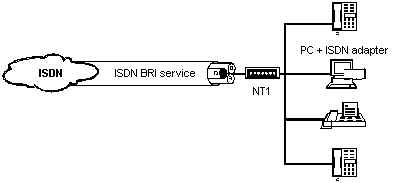Switching Methods
The process
of moving data through a network is called switching. As described later
on, ISDN takes advantage of two types of switching: circuit-switching and
packet-switching.
Circuit switching
Circuit switching
moves data between two points by setting up a physical link, or circuit,
between them. Data flows in a stream along a circuit that lasts as long
as necessary, at which time the switches and lines used to build the circuit
are freed for another connection.

The usual example of a circuit-switched network is the plain old telephone system (POTS) network, illustrated in Figure 2. When you dial a phone number, the phone company's switching equipment sets up a direct circuit between your telephone and the destination. The chief advantage of circuit-switching is that the flow of data (for example, your voice) is not subject to delays introduced by the network, and the recipient receives data exactly as it was sent. The big disadvantage, is that much of the connection's available bandwidth may be wasted due to the bursty nature of data traffic which will rarely saturate the link's capacity.
Packet-Switching
Instead of
moving as a continuous, orderly stream, data on a packet-switched network
is segmented into discrete units, or packets. Each packet contains a piece
of the original data, plus information about the sender, recipient, and
where that packet fits in with the others. Packet-switching networks simply
forward these packets from one switch to another until they arrive at their
destination. No direct, dedicated connection is ever formed. Consequently,
individual data packets may travel different routes to the same destination.

The advantage of packet-switching is that short messages can be transferred with little latency since no end-to-end link needs to be set up. Moreover, carrier bandwidth can be shared by a large number of customers, resulting in lower costs. The disadvantage is that the data transfer rate varies from one packet to the next, limiting the usefulness of packet-switching for voice or video applications which cannot tolerate variability.Examples of packet-switching protocols are X.25 and its faster and increasingly popular sibling, Frame Relay.